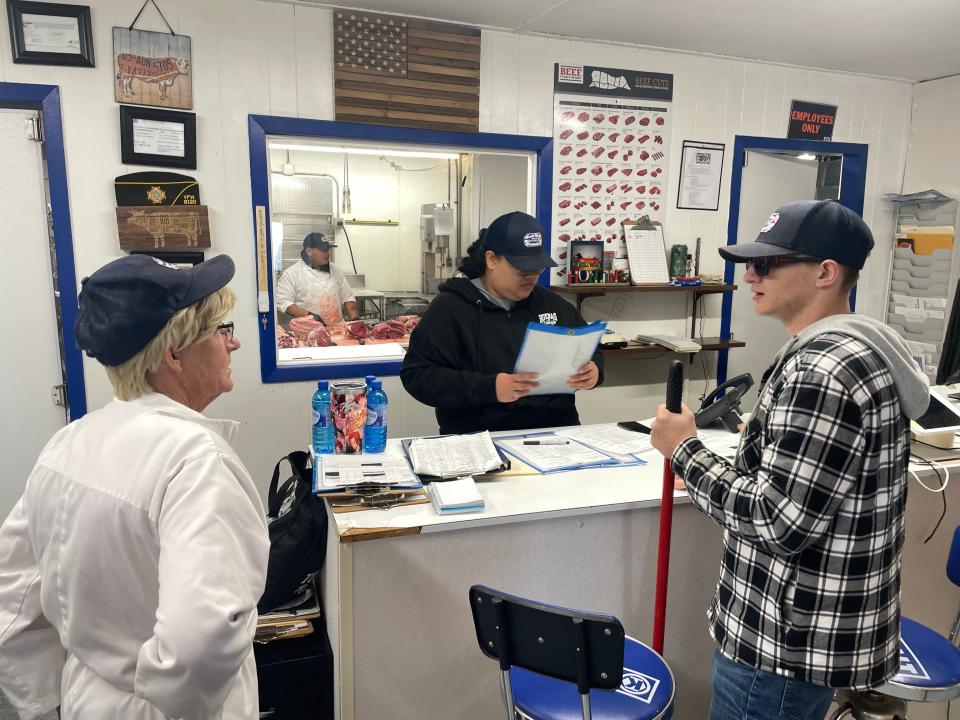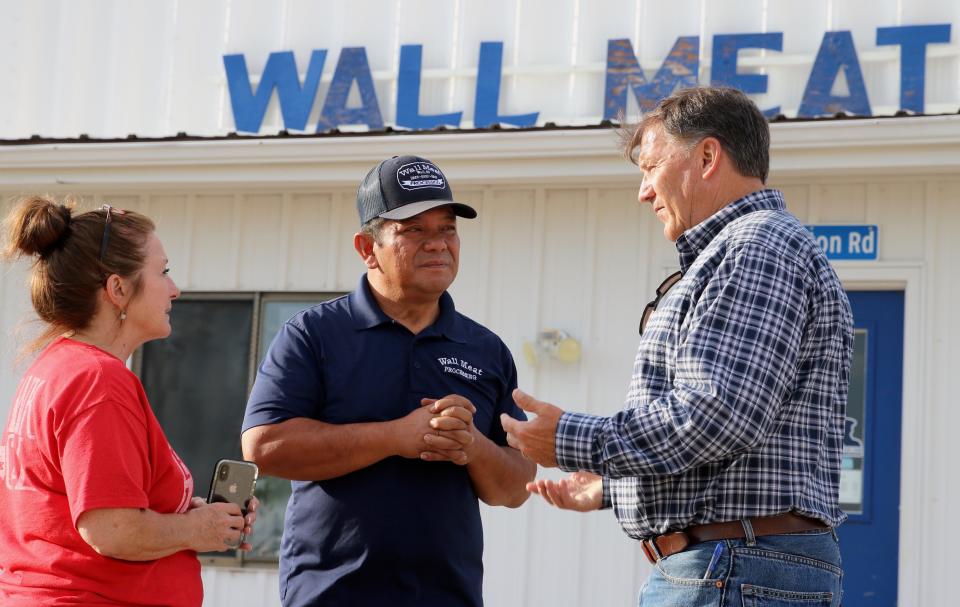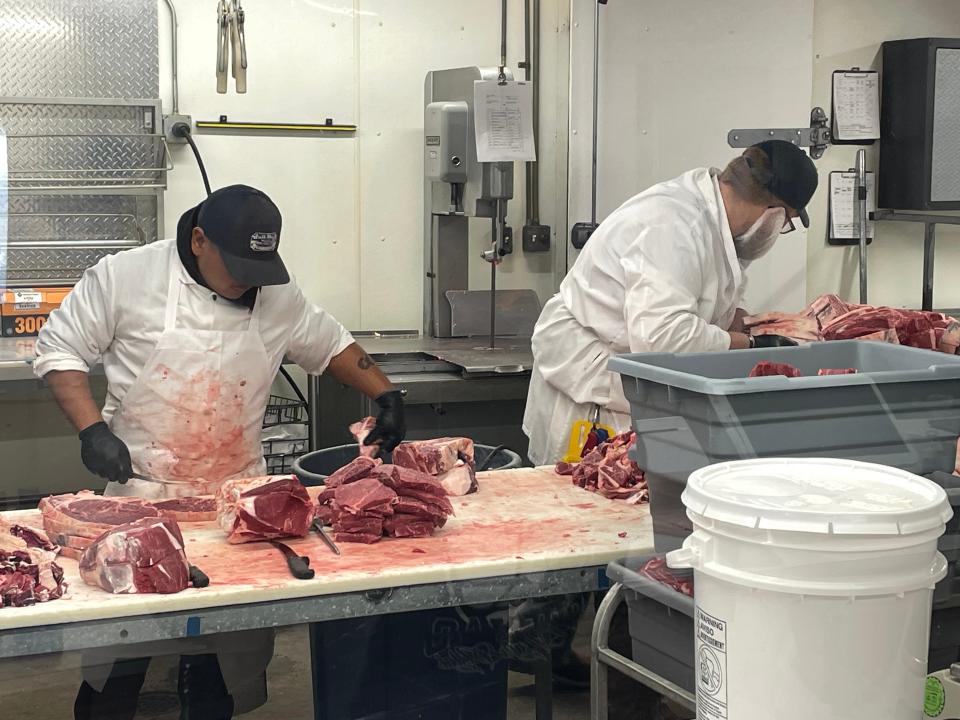South Dakota beef industry sees potential in small, local meat plants
WALL – The small, somewhat worn meat processing plant in rural Wall seems an unlikely place for the birth of a new trend in South Dakota agriculture. But it could fundamentally change the economic landscape for the state's $1 billion annual beef cattle industry.
The 2,400 square-foot Wall Meat Processing plant is the current home base of an aggressive, innovative new ownership team that has plans to revolutionize how South Dakota ranchers get their animals processed and expand opportunities for local consumers to buy meat raised almost in their own backyards.
On a recent day, a half-dozen or so workers were on task in the cramped but clean meat plant that sits less than a mile from Wall Drug. It's the last structure standing before the city of 700 fades into a nearly endless prairie to the north.

Built nearly 60 years ago, the boxy white plant takes in local cattle as well as a few hogs, sheep and buffalo and processes them from live animals to carcasses to final cuts of meat packaged in plastic, ready for consumer purchase. With a capacity of only 15 head of cattle per week, the plant hardly makes a dent in processing the roughly 1.5 million beef cows raised in South Dakota in 2022, the overwhelming majority of which are trucked out of state for processing.
But the two co-owners of the plant, who bought it in 2017 after the former owners shuttered the business for several months, are using what they have learned in Wall to develop a business expansion plan that agricultural leaders said could form the model for future development of a new generation of in-state regional meat processing plants.
More: Millions of grassland acres lost in Great Plains, new research report says
The local packing plants, they said, will allow more livestock grown in South Dakota to be processed, sold and consumed entirely within the boundaries of the Rushmore State. Local processing will create jobs and tax revenues, save ranchers money on trucking and packaging and create a fully South Dakota farm-to-table process that is increasingly popular among consumers.
The Wall owners and a third partner recently launched a new entity, I-90 Meats, which plans to build a $21 million, 30,000 square-foot meat processing plant in New Underwood, a town of 600 people located south of Interstate 90 midway between Wall and Rapid City.
The high-tech plant would have capacity to process 15 cattle a day, or about 4,000 a year, and would include a retail market, agri-tourism learning center and culinary demonstration area.

The plant, with a proposed groundbreaking in early 2024 and projected opening in 2025, could employ as many as 50 people with wages up to $36 an hour, according to I-90 Meats co-owner Ken Charfauros. The plant will process beef, pork, lamb and bison produced by local ranchers. It would sell those products at the plant store as well as a retail location in Rapid City and at other groceries across the West River region.
"South Dakota is fourth or fifth in cattle production in the nation, but we sell our cattle out of state and then buy it back, so it's kind of backwards," said Charfaurous.
Most South Dakota livestock are trucked out of state for finishing and packaging at one of the four major meat packing companies in the U.S.
More: T. Denny Sanford gives another $10M to Dakota State University's cyber research initiative
Producers pay more to have their animals transported and processed, and the state loses out on the resulting jobs and tax revenues. Consumers then pay more for products for which they have no idea whether the meat they are eating was raised in South Dakota, California or even Mexico or Brazil.
U.S. Sen. Mike Rounds, R-South Dakota, said further expansion of processing would be a win for both producers and consumers.
As livestock processing evolves, Rounds said he sees the growth of smaller processing plants around the state as a likely path forward.

“If our premises are correct, that people want to buy American beef because of its quality, then I think these smaller processors are going to continue to grow and I think they’re going to become the wave of the future," Rounds said.
The ongoing evolution of the meat packing industry in South Dakota is part of a larger statewide trend in which more agricultural products that are grown or raised in the state are being processed here.
Scott VanderWal, president of the South Dakota Farm Bureau Federation, said shipping products out of state for processing drives up costs for producers and eventually consumers.
“More local processing has been something we’ve needed for a long long time because for whatever reason, we’ve been happy in South Dakota just to produce things — corn, soybean, cattle and hogs — and ship them out of state for processing,” VanderWal said.
Troy Hadrick is part of a five-generation family legacy of farming and ranching in South Dakota. He and his family want to expand their business and provide another regional meat processing option for ranchers in northeastern South Dakota.
More: Feeding South Dakota will provide 6,000 Thanksgiving meals this year
The family’s plan is to build a $13.5 million meat plant, called North Prairie Butchery, that could process 25 head of cattle per day near their hometown of Faulkton.
Hadrick has qualified for a $2.2 million grant from the USDA to get the project started, though the money only comes in the form of a reimbursement.
Two years ago, the Hadricks made a deal to provide beef to the Vanguard Hospitality group of restaurants in Sioux Falls, which includes Morrie’s Steakhouse, Minerva's, Grill 26 and Paramount Cocktails and Food. The family sells them 60 to 70 carcasses a year, Hadrick said.
When the first shipment of beef was made to Vanguard, Hadrick took his two daughters out of school and brought them on the trip to Sioux Falls.
”It was exciting,” he said. “It was like a light bulb came on for our girls, that this is why we do all the work we do at home.”
— This article was produced by South Dakota News Watch, a non-profit journalism organization located online at sdnewswatch.org.
This article originally appeared on Sioux Falls Argus Leader: South Dakota beef industry sees potential in small, local meat plants
